The GIGABYTE Z170X-Gaming G1 Review: Quad-SLI on Skylake, and now with Thunderbolt 3
by Ian Cutress on December 1, 2015 9:30 AM EST- Posted in
- Motherboards
- Gaming
- Intel
- Gigabyte
- PLX
- PLX8747
- Z170
- Thunderbolt 3
CPU Performance, Short Form
For our motherboard reviews, we use our short form testing method. These tests usually focus on if a motherboard is using MultiCore Turbo (the feature used to have maximum turbo on at all times, giving a frequency advantage), or if there are slight gains to be had from tweaking the firmware. We leave the BIOS settings at default and memory at JEDEC (DDR4-2133 C15) for these tests, making it very easy to see which motherboards have MCT enabled by default.
Video Conversion – Handbrake v0.9.9: link
Handbrake is a media conversion tool that was initially designed to help DVD ISOs and Video CDs into more common video formats. For HandBrake, we take two videos (a 2h20 640x266 DVD rip and a 10min double UHD 3840x4320 animation short) and convert them to x264 format in an MP4 container. Results are given in terms of the frames per second processed, and HandBrake uses as many threads as possible.
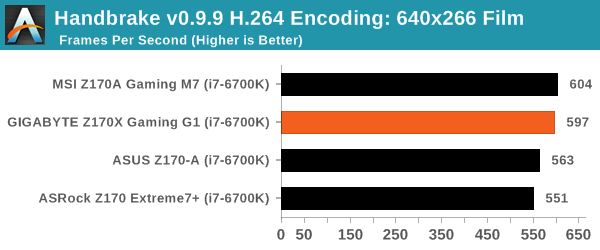
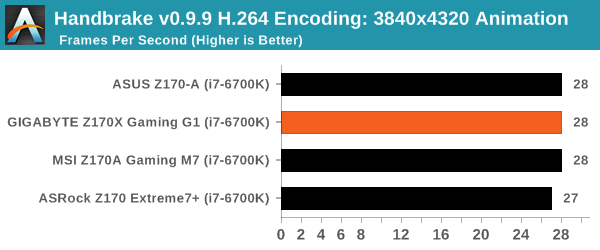
Compression – WinRAR 5.0.1: link
Our WinRAR test from 2013 is updated to the latest version of WinRAR at the start of 2014. We compress a set of 2867 files across 320 folders totaling 1.52 GB in size – 95% of these files are small typical website files, and the rest (90% of the size) are small 30 second 720p videos.
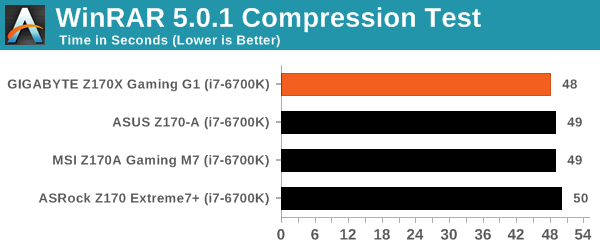
Point Calculations – 3D Movement Algorithm Test: link
3DPM is a self-penned benchmark, taking basic 3D movement algorithms used in Brownian Motion simulations and testing them for speed. High floating point performance, MHz and IPC wins in the single thread version, whereas the multithread version has to handle the threads and loves more cores. For a brief explanation of the platform agnostic coding behind this benchmark, see my forum post here.
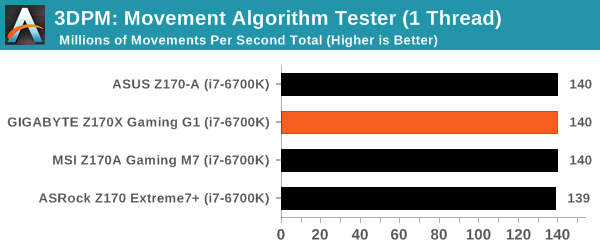
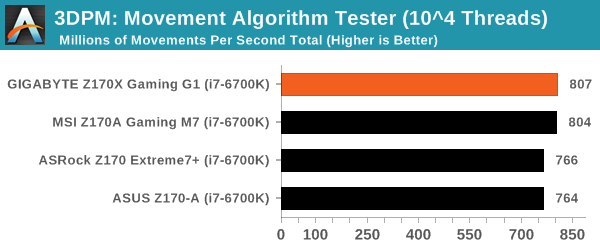
Image Manipulation – FastStone Image Viewer 4.9: link
Similarly to WinRAR, the FastStone test us updated for 2014 to the latest version. FastStone is the program I use to perform quick or bulk actions on images, such as resizing, adjusting for color and cropping. In our test we take a series of 170 images in various sizes and formats and convert them all into 640x480 .gif files, maintaining the aspect ratio. FastStone does not use multithreading for this test, and thus single threaded performance is often the winner.

Rendering – POV-Ray 3.7: link
The Persistence of Vision Ray Tracer, or POV-Ray, is a freeware package for as the name suggests, ray tracing. It is a pure renderer, rather than modeling software, but the latest beta version contains a handy benchmark for stressing all processing threads on a platform. We have been using this test in motherboard reviews to test memory stability at various CPU speeds to good effect – if it passes the test, the IMC in the CPU is stable for a given CPU speed. As a CPU test, it runs for approximately 2-3 minutes on high end platforms.

Synthetic – 7-Zip 9.2: link
As an open source compression tool, 7-Zip is a popular tool for making sets of files easier to handle and transfer. The software offers up its own benchmark, to which we report the result.
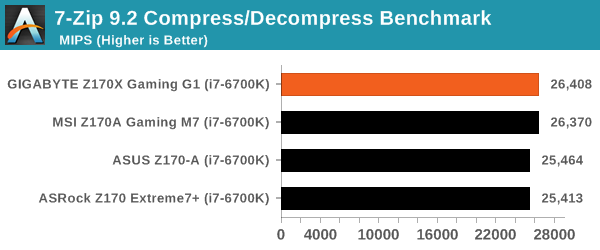










67 Comments
View All Comments
WasHopingForAnHonestReview - Wednesday, December 2, 2015 - link
Bingo.Mikemk - Tuesday, December 1, 2015 - link
What about a 5820k in an ASUS X99-E WS?Mikemk - Tuesday, December 1, 2015 - link
EDIT: I should clarify, I agree this is too expensive, but there are use cases (mainly with compute and servers) where it can be legitimate to have the motherboard cost more than the CPURaistlinZ - Tuesday, December 1, 2015 - link
Wouldn't someone buying a workstation mobo want a Xenon CPU, not a consumer grade CPU?Mikemk - Tuesday, December 1, 2015 - link
Well, if they just want GPU power with 7 GPUs, and doesn't care about CPU performance, the 5820k is relatively cheap way to get the system to bootGigaplex - Tuesday, December 1, 2015 - link
The 5820k has cut down PCIe lanes. You'd want the next model up for that many GPUs.bizude - Monday, December 14, 2015 - link
You could run a 3-way setup on a 5820k using 3.0x8/3.0x8/3.0x8 - just not a 4-way.jasonelmore - Tuesday, December 1, 2015 - link
A motherboard should cost more than the CPU. It has waaay more materials, Chips, Wifi, Controllers, Metal, Copper, Fiberglass, Connectors, Software, Cables, Features etc..,han a simple CPU made with .0005 gram of gold and even less copper. Mostly sand and aluminum.
thank intel for their 60% profit margin, where-as these boards have 20-30% margins
Zotamedu - Tuesday, December 1, 2015 - link
So no test of the most important feature, the quad SLI support? Running two GPUs in x8/x8 tends to work well but what happens when you kick in a third or fourth so you end up with x8/x8/x8/x8 that is multiplexed into a single x16? The PCIe bandwidth can be limited at x8/x8, how does the multiplexer perform?jasonelmore - Tuesday, December 1, 2015 - link
yeah i know right, he even states he has 4 290x's in his test setup.. didnt even run the test on it.